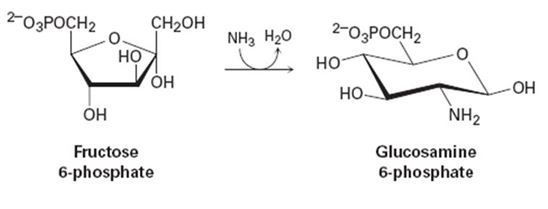
EBK ORGANIC CHEMISTRY
9th Edition
ISBN: 9780100591318
Author: McMurry
Publisher: YUZU
expand_more
expand_more
format_list_bulleted
Concept explainers
Textbook Question
Chapter 25.SE, Problem 32MP
Glucosamine, one of the eight essential monosaccharides (Section 25-7), is biosynthesized as its 6-phosphate derivative from fructose 6-phosphate by reaction with ammonia. Propose a mechanism.

Expert Solution & Answer
Want to see the full answer?
Check out a sample textbook solution
Students have asked these similar questions
When talking about the acidity of carboxylic acids, is it the same thing to say higher or stronger acidity?
Using the following two half-reactions, determine the pH range in which $NO_2^-\ (aq)$ cannot be found as the predominant chemical species in water.* $NO_3^-(aq)+10H^+(aq)+8e^-\rightarrow NH_4^+(aq)+3H_2O(l),\ pE^{\circ}=14.88$* $NO_2^-(aq)+8H^+(aq)+6e^-\rightarrow NH_4^+(aq)+2H_2O(l),\ pE^{\circ}=15.08$
Indicate characteristics of oxodec acid.
Chapter 25 Solutions
EBK ORGANIC CHEMISTRY
Ch. 25.1 - Prob. 1PCh. 25.2 - Prob. 2PCh. 25.2 - Prob. 3PCh. 25.2 - Prob. 4PCh. 25.2 - Prob. 5PCh. 25.3 - Prob. 6PCh. 25.3 - Prob. 7PCh. 25.4 - Prob. 8PCh. 25.4 - Prob. 9PCh. 25.4 - Prob. 10P
Ch. 25.5 - Prob. 11PCh. 25.5 - Prob. 12PCh. 25.5 - Prob. 13PCh. 25.5 - Prob. 14PCh. 25.5 - Prob. 15PCh. 25.6 - Prob. 16PCh. 25.6 - Prob. 17PCh. 25.6 - Prob. 18PCh. 25.6 - Prob. 19PCh. 25.6 - Prob. 20PCh. 25.6 - Prob. 21PCh. 25.6 - Prob. 22PCh. 25.6 - Prob. 23PCh. 25.7 - Prob. 24PCh. 25.8 - Show the product you would obtain from the...Ch. 25.SE - Prob. 26VCCh. 25.SE - Prob. 27VCCh. 25.SE - Prob. 28VCCh. 25.SE - Prob. 29VCCh. 25.SE - Prob. 30MPCh. 25.SE - Prob. 31MPCh. 25.SE - Glucosamine, one of the eight essential...Ch. 25.SE - D-Glicose reacts with acetone in the presence of...Ch. 25.SE - Prob. 34MPCh. 25.SE - Prob. 35MPCh. 25.SE - Prob. 36APCh. 25.SE - Prob. 37APCh. 25.SE - Prob. 38APCh. 25.SE - Prob. 39APCh. 25.SE - Prob. 40APCh. 25.SE - Assign R or S configuration to each chirality...Ch. 25.SE - Prob. 42APCh. 25.SE - Prob. 43APCh. 25.SE - Prob. 44APCh. 25.SE - Prob. 45APCh. 25.SE - Prob. 46APCh. 25.SE - Prob. 47APCh. 25.SE - Prob. 48APCh. 25.SE - Prob. 49APCh. 25.SE - Prob. 50APCh. 25.SE - Prob. 51APCh. 25.SE - Prob. 52APCh. 25.SE - Prob. 53APCh. 25.SE - Prob. 54APCh. 25.SE - Prob. 55APCh. 25.SE - Prob. 56APCh. 25.SE - Prob. 57APCh. 25.SE - Prob. 58APCh. 25.SE - Prob. 59APCh. 25.SE - Prob. 60APCh. 25.SE - Prob. 61APCh. 25.SE - Prob. 62APCh. 25.SE - Prob. 63APCh. 25.SE - D-Mannose reacts with acetone to give a...Ch. 25.SE - Prob. 65APCh. 25.SE - Prob. 66APCh. 25.SE - Prob. 67APCh. 25.SE - Prob. 68APCh. 25.SE - Prob. 69APCh. 25.SE - Prob. 70APCh. 25.SE - Prob. 71AP
Additional Science Textbook Solutions
Find more solutions based on key concepts
Give the IUPAC name for each compound.
Organic Chemistry
2. Why is it that the range of resting blood pressures of humans is best represented by a bell-shaped curve co...
Human Biology: Concepts and Current Issues (8th Edition)
Choose the best answer to each of the following. Explain your reasoning. If Earth were twice as far as it actua...
Cosmic Perspective Fundamentals
What were the major microbiological interests of Martinus Beijerinck and Sergei Winogradsky? It can be said tha...
Brock Biology of Microorganisms (15th Edition)
11. In the early 1800s, French naturalist Jean Baptiste Lamarck suggested that the best explanation for the rel...
Campbell Biology: Concepts & Connections (9th Edition)
Knowledge Booster
Learn more about
Need a deep-dive on the concept behind this application? Look no further. Learn more about this topic, chemistry and related others by exploring similar questions and additional content below.Similar questions
- What is the final product when hexanedioic acid reacts with 1º PCl5 and 2º NH3.arrow_forwardWhat is the final product when D-galactose reacts with hydroxylamine?arrow_forwardIndicate the formula of the product obtained by reacting methyl 5-chloro-5-oxopentanoate with 1 mole of 4-penten-1-ylmagnesium bromide.arrow_forward
- The temperature on a sample of pure X held at 1.25 atm and -54. °C is increased until the sample boils. The temperature is then held constant and the pressure is decreased by 0.42 atm. On the phase diagram below draw a path that shows this set of changes. pressure (atm) 2 0 0 200 400 temperature (K) Xarrow_forwardQUESTION: Answer Question 5: 'Calculating standard error of regression' STEP 1 by filling in all the empty green boxes *The values are all provided in the photo attached*arrow_forwardpressure (atm) 3 The pressure on a sample of pure X held at 47. °C and 0.88 atm is increased until the sample condenses. The pressure is then held constant and the temperature is decreased by 82. °C. On the phase diagram below draw a path that shows this set of changes. 0 0 200 temperature (K) 400 аarrow_forward
arrow_back_ios
SEE MORE QUESTIONS
arrow_forward_ios
Recommended textbooks for you
 Introduction to General, Organic and BiochemistryChemistryISBN:9781285869759Author:Frederick A. Bettelheim, William H. Brown, Mary K. Campbell, Shawn O. Farrell, Omar TorresPublisher:Cengage Learning
Introduction to General, Organic and BiochemistryChemistryISBN:9781285869759Author:Frederick A. Bettelheim, William H. Brown, Mary K. Campbell, Shawn O. Farrell, Omar TorresPublisher:Cengage Learning
 Organic ChemistryChemistryISBN:9781305580350Author:William H. Brown, Brent L. Iverson, Eric Anslyn, Christopher S. FootePublisher:Cengage Learning
Organic ChemistryChemistryISBN:9781305580350Author:William H. Brown, Brent L. Iverson, Eric Anslyn, Christopher S. FootePublisher:Cengage Learning

Introduction to General, Organic and Biochemistry
Chemistry
ISBN:9781285869759
Author:Frederick A. Bettelheim, William H. Brown, Mary K. Campbell, Shawn O. Farrell, Omar Torres
Publisher:Cengage Learning


Organic Chemistry
Chemistry
ISBN:9781305580350
Author:William H. Brown, Brent L. Iverson, Eric Anslyn, Christopher S. Foote
Publisher:Cengage Learning
Lipids - Fatty Acids, Triglycerides, Phospholipids, Terpenes, Waxes, Eicosanoids; Author: The Organic Chemistry Tutor;https://www.youtube.com/watch?v=7dmoH5dAvpY;License: Standard YouTube License, CC-BY